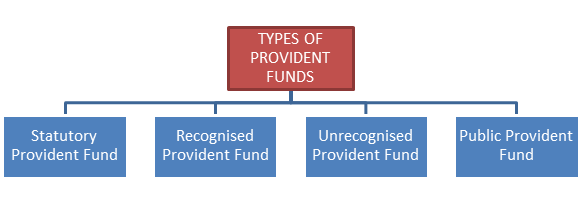The main reasons that the Government has set up various kinds of provident funds is to encourage savings for the social security of employees. Generally the employee contributes a fixed percentage of his salary towards these funds and in many cases employer also contributes. The whole contribution along with interest is credited to employee's account. The payment can be extracted out of this fund at the time of retirement and at some other important occasions.
Provident Funds are of four kinds:

Now let us discuss all these types in detail.

(a) Statutory Provident Fund
Statutory provident fund was started in the year 1925 through a Provident Fund Act of 1925. The fund was started with a view of promoting savings amongst government employees. Generally, this fund is maintained by Government or Semi-Government Departments like Railways, Reserve Bank of India. Colleges, Universities, local bodies, insurance companies, etc.
Tax implications
The employer's contribution towards the employee's statutory provident fund and the amount of interest earned on the accumulated balance to the employee's credit balance are not to be included in the income of employee and so it is ignored. The employee's own contribution will qualify for deduction u/s 80C. At the time of retirement or when he leaves the service and receives any amount from the accumulated balance to his credit in the statutory provident fund, the amount so received will not be included in employee's total income [Section 10(11)] being exempted income.
(b) Recognised Provident Fund
This is a fund to which the Commissioner of Income-tax has given the recognition as required under the Income-tax Act. Generally this fund is maintained by industrial undertakings, business houses, banks, etc.
Tax implications
The employer's contribution over and above 12% of employee's salary, will be included in employee's salary income for tax purposes. The employee's contribution towards this fund will fully qualify for deduction u/s 80C.
Interest on Provident Fund credit balance upto prescribed rate is exempted, but interest credited over and above such rate ( 9.5%) is deemed to be employee's salary income and is included in salary income of that previous year.
(c) Unrecognised Provident Fund
It is the provident fund which is not recognised by the Commissioner of Income-tax. The employee and the employer both contribute towards this fund.
Tax implications
The employee's contribution is added in this salary if net is given and he will not be allowed any deduction u/s 80C regarding this contribution while computing the total income of the employee. The employer's contribution and interest on the accumulated credit balance of the fund are not to be included in employee's salary income from year to year.
The payment received out of this fund is taxable so far it represents the employer's contribution and interest thereon. The employee is entitled to relief under section 89(1). The employee's contribution is ignored because it was taxed when it was contributed. It is to be noted that the Interest on the employee's own contribution will be taxable as 'Income from Other Sources' and not as salary income.
(d) Public Provident Fund
The above mentioned funds were for salaried persons. A new fund known as public provident fund was started on July 1, 1968 so that self-employed people may also enjoy the benefit of deduction u/s 80C. This fund is simple and pocket friendly. The subscription can be between 500 and 1,50,000 in one year. At one time one can deposit in multiples of 50 and in one month only one deposit is possible and in the year minimum subscription should be 500 and the maximum 1,50,000. Full withdrawal is possible after 15 years but in case of death of the subscriber full repayment will be made to the legal heir of nominee. Partial withdrawal and loans are also possible.
Tax implications
The subscription towards this type of fund is eligible for deduction in the similar manner, as in the case of statutory provident fund. Interest credited in this account is fully exempted.
Transferred balance
When the unrecognised provident fund is recognised for the first time, the credit balance in the employee's unrecognised provident fund is transferred to the recognised provident fund account. This balance is known as transferred balance. In such case fund will be treated as RPF from the day of its inception and exemption will be allowed in same manner. Only excess of amount transferred to RPF over exempted amount shall form taxable portion of transferred balance.








 CAclubindia
CAclubindia

